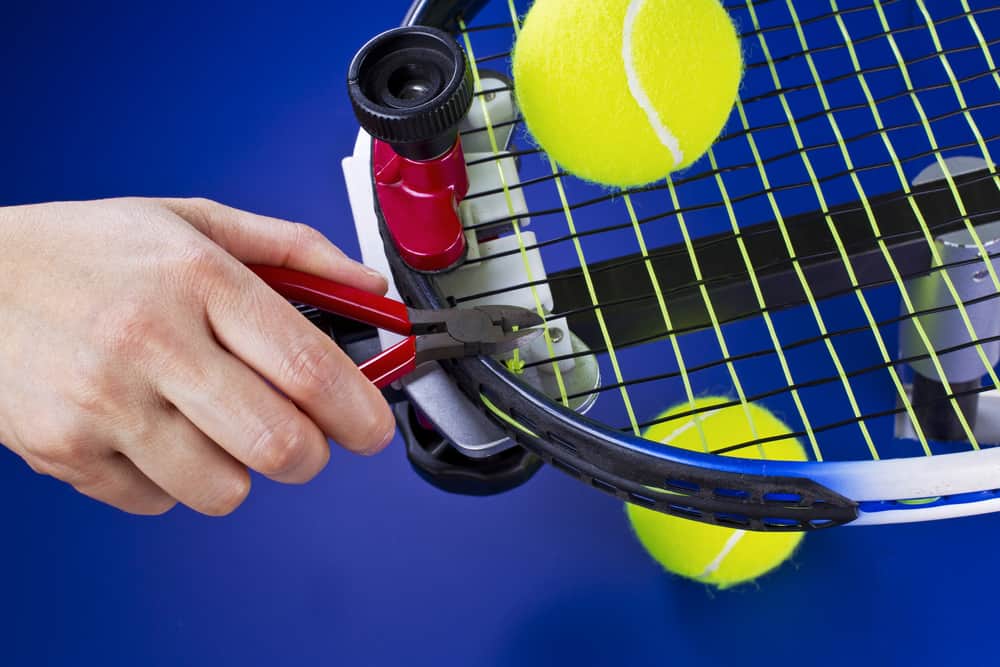Racket stringing is the process of attaching strings to a racket frame to create a functional playing surface. There are two main methods of racket stringing: one-piece stringing and two-piece stringing. The debate over which method is better has been ongoing for many years, with players having strong opinions on both sides.
Today, we’ll be going over the advantages and disadvantages of each method to help you make an informed decision on which is better for your specific needs.
POINTS
- Racket stringing is the process of attaching strings to a racket frame and there are two main methods: one-piece stringing and two-piece stringing.
- One-piece stringing provides increased power, but can reduce ball control due to lack of seams in the playing surface. It is best suited for players who value power over customization options.
- Two-piece stringing offers better durability, more customization options, greater spin potential, and improved ball control; however it may reduce overall power compared to one piece strining. This method is ideal for players looking for more flexibility when making adjustments or those who prefer different tensions on each section of their racket frame.
- The choice between one or two pieces should be based on personal preference as well as playing style and racket specifications while also taking into account which type will benefit individual types of players (beginners vs advanced).
One-piece stringing
One-piece stringing involves stringing the racket with a single piece of string. This method is considered to be more traditional and is often favored by older players.
The main advantage of one-piece stringing is increased power. The lack of seams in the stringbed creates a more solid playing surface, which can result in greater power and control when hitting the ball. Additionally, one-piece stringing is known to create a more consistent stringbed, which can be especially beneficial for players who prefer a specific feel when playing.
But one-piece stringing does have some disadvantages. One of the main drawbacks is that it provides less string movement, which can lead to a decrease in ball control. Another potential problem is that it can reduce the overall durability of the stringbed. This is because the lack of seams can make it more difficult to absorb the shock from powerful shots, which can lead to the stringbed breaking down over time.
Overall, one-piece stringing is best suited for players who value power and control over customization options. Those who are looking for a more traditional playing experience may also prefer one-piece stringing.
Two-piece stringing
Two-piece stringing involves dividing the racket stringing into two separate sections and attaching each section to the racket frame individually. This technique provides greater durability and is a popular choice among players who value customization options.
The main advantage of two-piece stringing is that it allows players to make adjustments to their stringbed by replacing only one section of the string rather than the entire stringbed. This is great for players who want to change the string tension or stiffness of their racket, as they can do so without having to restring the entire racket.
Two-piece stringing also comes with better string movement for increased ball control. The extra movement in the stringbed allows for more spin to be generated, which can be especially beneficial for players who rely on topspin or slice shots. This method also has tons of customization options. Customization options, as they can choose different string types, gauges, and tensions for each section of their racket stringing.
One of the arguments against two-piece stringing is that it can reduce power compared to one-piece stringing. The extra seams in the stringbed can make the playing surface less solid and the hit less powerful. This method can also create an uneven stringbed, as the different sections of strings may have varying levels of tension or stiffness.
Two-piece stringing is ideal for players who value customization options and string movement over power and control. Players who frequently make adjustments to their stringbed or who prefer to have different sections of string with different tensions may find that two-piece stringing is a better choice for their needs. However, players who value power and control over customization options may prefer one-piece stringing.
Comparison of one-piece and two-piece stringing
When choosing between one-piece and two-piece stringing, it’s important to consider a number of factors. These included playing style, racket specifications, and personal preference. You should also know which type of stringing is best for different types of players, from beginners to advanced.
One of the main factors to consider when choosing between one-piece and two-piece stringing is playing style. Players who rely on power and control may prefer one-piece stringing, as it provides a more solid playing surface and can result in increased power and control.
On the other hand, players who need spin and customization options may prefer two-piece stringing, as it provides greater string movement and flexibility. Racket specifications are another important factor to consider when choosing between one-piece and two-piece stringing.
Anyone who uses a racket with a smaller head size may find that one-piece stringing is a better choice, as it can provide a more consistent stringbed and improve ball control. Players who use rackets with larger head sizes may find that two-piece stringing is a better choice, as it provides greater durability and allows for more customization options.
Personal preference is also a key factor to consider when choosing between one-piece and two-piece stringing. Some players may prefer the traditional feel of one-piece stringing, while others may prefer the customization options and string movement provided by two-piece stringing. Ultimately, the decision of which method of stringing to choose is a personal one and should be based on what feels best for each individual player.
Finally, it is also helpful to understand which type of stringing is better for specific types of players. Beginners, for example, may find that one-piece stringing is a better choice, as it can provide a more consistent playing surface and improve ball control. Advanced players may prefer two-piece stringing, as it’s more personalized and allows for more precise adjustments to be made to the stringbed.
FAQ
What is the best string pattern for a tennis racquet?
The best string pattern for a tennis racquet depends on the player’s playing style, racket specifications, and personal preferences. Players who prefer power and control may opt for a tighter string pattern, while those who prefer spin and customization options may prefer a looser pattern.
What racket string do pros use?
Many professional tennis players use a variety of different strings, depending on their playing style and preferences. Some popular brands among pros include Luxilon, Babolat, and Wilson.
Which tennis string holds tension the best?
Each string type will hold tension differently, but synthetic gut and multifilament strings are known for their ability to maintain tension well.
Does string pattern make a difference?
Yes, the string pattern of a tennis racquet can have a significant impact on the player’s performance. A tighter string pattern can provide more power and control, while a looser pattern can provide more spin and customization options.
Do tighter strings give more power?
Tighter strings can provide more power, as they create a more solid playing surface and transfer energy from the racket to the ball more efficiently, but they can also result in decreased ball control and reduced string movement.
Conclusion
The choice between one-piece and two-piece stringing, as well as the string pattern, are all personal decisions that depend on the player’s playing style, racket specifications, and personal preferences. Both stringing methods have their pros and cons, and players should experiment with both to determine which type of stringing works best for their needs.
The string pattern can also have a significant impact on a player’s performance, which is important to consider when choosing between different stringing options. We encourage you to try both techniques out for yourself to discover which string pattern is most beneficial to you.
 Written by Mark Sampson
Written by Mark Sampson